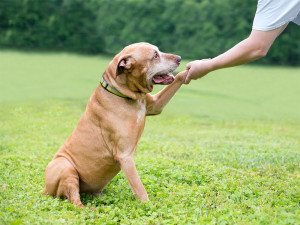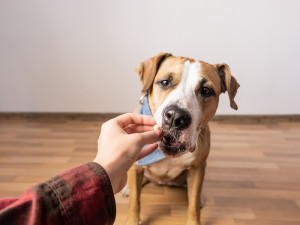How to Teach Your Dog to ‘Talk’ at the Touch of a Button
Cognitive science professor Dr Federico Rossano on how Bunny, TikTok’s ‘talking’ dog, is sparking change in how we communicate with our pets
During the pandemic, lots of people not only adopted pets, but also spent exponentially more time with the ones they already had. This resulted in stronger bonds and some pretty next-level pet-related hobbies. The most elaborate of them all? Teaching your pet how to communicate using a variety of push buttonsopens in new tab.
Bunnyopens in new tab, a Sheepadoodle sensation on TikTok, is probably the most recognisable ‘talking’ dog on social media, garnering millions of views around the world. In one video, you can see Bunny press buttons to express her ‘mad’ feelings about baths. In another, she alerts her mom to an ‘ouch’ in her ear. She even got existential by showcasing her ability to recognise herself in a mirror, dreaming of more rainopens in new tab, and questioning whether her new brother (a dog named Otter) was a human or a dog.
Get (totally free) deals for food, treats, accessories, tech and way more pet parenting must-haves.
It’s not just obsessive pet parents who are getting into pet communication. Even scientists are dialling things up, thanks in part to an increased number of pet owners who are volunteering for scientific research. “From a scientific point of view, if we said this 40 years ago, people would think us was crazy. We had no reason to believe [that pets could communicate with us],” says Dr Federico Rossano, director at Comparative Cognition Lab at University of California San Diego. “But in 2020, we have enough scientific evidence that says dogs are better at understanding communicative signals from humans than chimpanzees.”
Dr Rossano leads a project that includes Bunny and other social media-famous animals. (Though he notes that he’s not following all of their accounts closely and has a different methodology for studying animals’ cognitive progress.) “If all there was out there was Bunny, I wouldn‘t be doing this study,” he says. “The reality is that there are many other dogs nobody has ever heard of who are doing things that are similar to what Bunny has been doing.”
These days, Dr Rossano’s team is studying and tracking the process of thousands of participants in 47 countries. Many of them have been inspired by the experience of San Diego-based speech pathologist Christina Hungeropens in new tab, who shares her methods on social media as Hunger4Wordsopens in new tab and published a book earlier this year called How Stella Learned to Talk: The Groundbreaking Story of the World's First Talking Dogopens in new tab.
Rosa Maglione, dog mum to Piperopens in new tab, is just one pet parent inspired by Hunger. “I watched her videos and was curious about how she was able to teach her dog words,” she says. “I wanted to try it myself, so I got ahold of some answer buzzers.” Piper started out with one to three buttons, and has now progressed to more than 47 buttons in a year.
Of course, not all animal performances you see on social media can be taken at face value. Scientists apply different tests to be able to track and study animals’ cognitive abilities in an unbiased way. “Many scientists are not convinced that pets have a full understanding of what they’re asking for when they press the buttons,” Dr Rossano explains. “That’s the first thing we need to prove.”
Want to get in on the trend? While research is still in progress, you can join one of the ongoing studies. Or you can get started with a small kit and then expand as your pet learns more and more words. Some pet owners have even built their own dog computeropens in new tab.
If it sounds intimidating, both Dr Rossano and Rosa compare the process to teaching kids how to speak. “It’s less like training and more like teaching a child to talk – you just incorporate it into your routine,” says Rosa. “We started with the word ‘outside’. Piper was a puppy and had to go pee all the time, and that was a word we were saying constantly.”
If you want some inspiration, there are plenty of social accounts to follow, from Bunny the Dog to the fast learner Parkeropens in new tab, and a blind cat called Jasperopens in new tab – who has sadly now passed away but left a legacy of superior cat intelligence behind. The website TheyCanTalk.orgopens in new tab is a good place to start. Countless pet parents who are experimenting with teaching pets how to communicate in new ways see themselves as pioneers in reaching a new era of understanding companion animals’ cognitive abilities. “Pet parents know their animal better than anybody else,” says Dr Rossano. “So they might be able to teach them things at home that would be impossible to teach in a lab because it would be an unfamiliar environment.”
Still, every dog is different – and learns at a different pace. So someone else’s experience on social media may be dissimilar to yours depending on your pet’s age, breed, or general disposition to learning. The benefits of teaching your pet how to communicate are numerous and will undoubtedly improve their quality of life: your dog could let you know when they need their water bowl refilled or when they have a preference in which type of game they want to play. “I didn’t realise just how much dogs want specific things,” says Rosa. “I’ll give her the choice between playing tug or fetching a ball – and she has a preference!”








